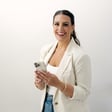Become a Creator today!Start creating today - Share your story with the world!
Start for free
00:00:00
00:00:01

Episode 235 - 10 Steps to Migrating Website Platforms
Last week, we launched a brand new website. This project has been months in the making, and finally seeing it live feels like we can check off one of the major goals for the year.
Would you rather watch a video? Links, resources and the full video can be found in the show notes. Check ’em out at https://daveyandkrista.com/how-to-migrating-website-platforms/. And if you enjoyed this episode, please consider leaving a review over at Apple Podcasts.
Transcript
Introduction to the Podcast and Hosts
00:00:01
Speaker
You're listening to The Brands That Book Show, a podcast for creative entrepreneurs who want practical tips and strategies to build engaging brands and craft high converting websites. We're your hosts, Davey and Krista, co-founders of a brand and website design agency specializing in visual brand design and show it websites. You're listening to The Brands That Book Show.
Excitement Over New Website Launch
00:00:25
Speaker
Okay so last week was a really exciting week for our team because after months um of hard work we launched a brand new website.
Transition from WordPress Elementor to Show It
00:00:35
Speaker
I'm really excited about this project. I love the design and I think that one of the coolest things about this project is that it included a major website platform shift. so we shift from the WordPress Elementor WooCommerce platform over to a show it WordPress WooCommerce platform. So a big platform shift meant a lot of extra little details to keep track of. And so today I'm going to walk you through what we did to ensure a smooth transition to a new website platform.
Journey from Hand-coded HTML to WordPress
00:01:06
Speaker
But first, let me tell you guys a little bit of the backstory. So we first launched this business in 2010, which honestly, it's crazy to think that it's been around that long.
00:01:16
Speaker
um And back then, and my and the very first iteration of my website was a straight HTML version. So I hand coded all the pages of the site and I actually at that time didn't really understand how to blog. So I thought that I should do an HTML page for each blog post, which is like so not ideal. Took way too long.
00:01:39
Speaker
I realized pretty quickly that I should learn how to do WordPress and build WordPress websites and WordPress themes because it was going to make my life so much easier. So I bought a book on WordPress theming with a lot of PHP and I read through it and I learned how to build websites on WordPress.
Discovery of Show It Platform
00:01:58
Speaker
And that's what I did for several years.
00:02:00
Speaker
So fast forward to about 2016, and I was at a WPPI conference, which is a photographer conference, and I met Todd Watson, who is the CEO of Show-It. And he showed me the brand new Show-It website platform that they were just releasing. So if you've been around in the creator world for a long time, you might remember that way back when Show-It websites used to be built on Flash, which Flash websites had their heyday, and I think that when the iPhone came out, they decided not to support Flash websites. And so that kind of quickly killed Flash. So Todd showed me the brand new, what was called Show It 5 at the time. And it was an HTML-based editor. It fully integrated with WordPress. And he showed me how easy it was to edit your website without any code.
Challenges and Solutions with E-commerce Integration
00:02:51
Speaker
And so
00:02:52
Speaker
He sold me pretty quickly and I built our newest version of our website at that time on Show It. I think in that same year, we also released our first set of Show It website templates. So again, this is 2016. And at that time, we used Shopify to do our cart checkouts for those products. So with Shopify, we created embeddable buy now buttons that we embedded on our Show It site and that took people over to but Shopify platform for him to do their checkout. And going that route had a few limitations. I think that Shopify is a really good ah platform if you're just getting started with e-commerce. But as shops grow, it's kind of hard to connect those embedded buttons with a fully functional shop on Show It. So I think a couple years into that, we switched over to doing Thrivecart for our checkouts.
00:03:45
Speaker
And that worked really great for a while because it allowed us to do payment plans and subscriptions to our products. It allowed us to do upsells and some more integrations than Shopify previously had let us do. But we realized pretty quickly that as people were purchasing products on our website, if they wanted to buy a full website template and an add-on page, so like a pricing page or our wedding guide. They had to go through the cart checkout system twice, which was pretty ideal. you know Thrive cart used to be really great for one-off products. Thrive cart was great for people who wanted to buy a product once. So like if you're selling a course, it was great. um But it wasn't great if you have an e-commerce shop where people are buying multiple products at once, and we realized it was probably hurting the total value of our cart sales.
00:04:31
Speaker
so So in 2018, we started building our team and adding in new team members. And that gave us the ability to look in alternative platforms like WooCommerce and Elementor. We like the idea of WooCommerce because it would have allow our products to populate in more of a shop platform. It would all be on our site. So the checkouts and the products and everything would stay on our DaveyandChrissa.com URL.
00:04:55
Speaker
instead of going over to the Shopify platform or the Thrivecart platform to do the checkouts.
Frustrations with Elementor and Return to Show It
00:05:00
Speaker
So we like that from an ads targeting perspective. And we also were excited about the abilities and the capabilities of WooCommerce because it there's so many plugins out there and so you can really do a lot with a WooCommerce shop.
00:05:13
Speaker
And at that time, WooCommerce really didn't work on the show platform. And I should note that technically, it show it still doesn't fully support WooCommerce from like a help perspective, but show it and WooCommerce play much better together than they did in the past. um And I think they're really great, powerful combination, which is why we have ended up going back to that route. So we used to show it So we use that Elementor, WooCommerce, WordPress, combination for several years and it served us really well until recently. So Elementor has made a lot of changes. They've switched from like more of a column space approach to this thing they're calling a flexbox approach and I have really struggled to grasp it and to get things to look the way that I want them to look.
00:05:59
Speaker
um I've been getting increasingly frustrated by the crazy amount of plugins that it takes to run that elemental website. I think at one point we were up to 70 plugins just to get it to look the way that we wanted to, function the way we wanted to, and be a fast loading site. It was a really heavy site. It was a really fragile site.
00:06:19
Speaker
And it felt like every day there were new plug-in vulnerabilities and we had to em make updates and when I'd make those updates, fonts would break and images would go missing and layouts would change and it just didn't look the way that I wanted it to look. And I was getting really frustrated because I couldn't do as beautiful of a design as I could on Elementor as I couldn't show it.
00:06:41
Speaker
so Yeah, it was just a lot of, there's a lot of struggle for me and a lot of pain. And as a designer, I really shouldn't be limited or feel limited by my own website. Last year, we also had to upgrade our own individual website hosting plan and we were playing hundreds of dollars a month just to keep our website functional, which yeah, it's painful.
00:07:06
Speaker
So with all of those frustrations, I decided to start exploring how to move our website back to show it, um especially because in this year, 2024, when I record this, show i and we're show it and commerce work a lot better together.
00:07:22
Speaker
And this was a massive undertaking because our website was over 150 pages. We probably have 150 products in our shop, although not all of them are active right
Comprehensive Transition Plan to Show It
00:07:32
Speaker
now. I think we only have about 60 active right now, but we didn't want to lose the data from those products because We have records of who has purchased those products um and sometimes we also still have active payment plans going for some products even if they're not for sale any longer. So we really needed to be organized and intentional with moving all of this content back over to show it. So I'm going to share exactly how we did that. The first thing that we did was outline this design and then I started literally designing each page in
00:08:05
Speaker
And then I just started designing each page in Sketch. Sketch has been my design platform of choice for many years. I know a lot of people also really like Thema. And I took screenshots of our existing site and inspiration from different things that I wanted to update our brand and update our website to. And I started working through all the different sections of the site and figuring out the layouts and the colors and the fonts before I started building and show it. So I think it's really important to do this, especially if you're working on a new design or a design from scratch. I never just jump right in to show it and start building. I work out all of my thoughts and edits and changes in Sketch before I build. The second thing we did was create a spreadsheet that was outlining every single existing page on our website. So um one of our team members, my wonderful admin Kayla, went through every page on our previous WordPress website and made a list of them.
00:09:00
Speaker
And then we noted what we didn't need anymore and that we could add a redirect to later in this process. We noted what needed updating, what needed to be rebuilt. And then we started assigning different team members, different pages of the build um and of the design process. So doing that spreadsheet was really helpful because it helped us make sure that we got all of the pages, that we didn't miss anything and that we were keeping track of what we had left, what could be repeated and so forth.
00:09:27
Speaker
We also noted any special content such as embedded forms and tried to actually grab that embed code and put it in the spreadsheet so it was really easy to copy and paste and to show it. Third thing we did was to start building in show it. So once we had that spreadsheet and once I had designed several new pages in Sketch, I started to build out the first few pages in show it.
00:09:47
Speaker
And once I had done the home page, of the about page, and a few sections of some other pages, that gave my team enough of a starting point to copy my styles, copy some of my pages and my settings, and start easily and quickly building the rest of the pages. and As you can imagine, with over 150 pages, it would have taken me a really long time to build every single thing by myself. um And this definitely wouldn't have happened if we didn't have a wonderful team of designers helping me get this done.
00:10:15
Speaker
We built our website in Show It on a staging site at first and that allowed us to keep our current site up and that allowed us to ensure that everything was working in Show It. It allowed us to do a lot of testing which I'll talk a little bit more about in a minute. This is about the time where we also made a copy of our previous WordPress website over to the Show It staging like WordPress area and their team actually helped us do this so that we had all of our products, all of our orders and we could really make sure that all of the Show It pages worked perfectly with WordPress um because with all the WooCommerce functionality, there was just a little bit more involved than a typical like six-page photographer website. Once we had built every page in the site, we started testing. All of the members of our team went through and we tested the design layout, we tested links, we read through the grammar, we made sure that everything was connected and because we wanted to get all of those like bugs and issues worked out before we made the site live.
00:11:11
Speaker
and had like thousands of eyes on the website. And then since we have a cart system and we do e-commerce, I also went through and I made a 99% off coupon code and tested a few products just to make sure that the transactions were actually going through. I think that it's important to have that monetary transaction to ensure that platforms like PayPal and Stripe are working and because if you're doing like a ah free product, it's just not the same transaction as if somebody actually has to put in those credit card information. so If we hadn't done that, we might not have caught that our PayPal was a little buggy and I ended up switching how our PayPal is connected to our site.
00:11:50
Speaker
if The fifth thing that we did was make sure that all of our tracking codes were integrated. So we use a Facebook Pixel to track traffic and run ads to our site. We use Google Analytics again to track traffic to see where that traffic is coming from and to look at statistics like how many people are on our website, what they're looking at, how long they spend on our website, <unk> etc.
00:12:10
Speaker
I made sure that our Badal code was on our website because we use Badals to deliver smart pop-ups to visitors. and And I'll share a link about how I do that down below. And then we also have a few tracking codes and platforms that show social proof on our website. So I made sure that those were linked as well. The sixth part of this process was working directly with the Show It team to do one last content poll of any updated blog posts or product orders or payments on our website.
00:12:38
Speaker
um and make sure that our GNS records were updated correctly and that everything went live really smoothly.
Launch Preparation and Execution
00:12:46
Speaker
um One of the best things about ShowIt is that they have an amazing team of real humans who actually care about your success and I really appreciated how hands-on they were in this process with me to make sure that there were no hiccups.
00:12:59
Speaker
this is This is probably one of the smoothest website transitions that I've ever seen happen. And I know that's because Show It Team was so intentional in helping us make this site live. So thank you, Show It. And if you're going live on Show It for the first time, you can work with them to do a content poll of your WordPress or Squarespace blog posts. And they'll also guide you through the process of updating your DNS records. So that means pointing your URL, your domain name over from
00:13:29
Speaker
wherever you hosted your website previously to show its hosting. Once our website was live, I knew that there were going to be some broken links on the site because there were pages on the old site such as old client projects that I wasn't going to build on the new site because they just were a little out of date or I had other projects that I wanted to show off. so One of the things that that I did was I used the RankMath plugin. um So RankMath is an SEO plugin. We use that on all of our blog posts um and to help us optimize the pages of our site. And within RankMath, I think this might just be in the paid version, um there's a plugin that goes with it called Redirections.
00:14:09
Speaker
And so you can easily use this Redirections plugin to add redirects from old pages that no longer exist on your site to a different page on your website. So in a lot of cases, if I was deleting a client project, I would point it from that previous yeah URL just in case that it had been shared somewhere or pinned on Pinterest to our custom design page or to our homepage or to our shop page.
00:14:34
Speaker
This is something that I think is really important to do because it's not great for search engine visibility if you have a lot of broken links on your website or links on the internet are going to broken pages of your website.
00:14:47
Speaker
At the same time that all of this was happening, we were also working on creating a launch strategy but because we knew that when we went live, we wanted to drive a lot of eyes and really show off all the different aspects of our projects. So we worked on recording a few YouTube videos ahead of time, some podcast episodes, we put out a few blog posts, and then we also set up a series of social posts to hint at the new website and and then to share about the new website once it was live and try to teach people how to do a few things that we did on the website just to make it more exciting. We decided to host a sale on our website at the time of launch, so I put a countdown timer on our website. We prepped a set of ads on Facebook to drive traffic to the website, and we used a few different plugins on the website to automatically apply that coupon and cross off the regular price to show the sale price on the website. And so that one is called WooCommerce Discount Rules. I think I'll link it below.
00:15:44
Speaker
Another thing that I want to note is that we went live a full week before we actually announced the new website. So we went live on a Wednesday a couple weeks ago and then we tested everything for a week before we started actually sharing the new website. So it was up and people could have seen the website but we weren't actually telling people that it was live for a full another week just to make sure that there were no other issues with the website.
00:16:10
Speaker
After the website had been live for a day or so, I ran an SEO on the website to do a like triple check for any broken links or any major ah SEO issues on the site. So I used a tool called Ubersuggest. We actually use this on all of our client projects at the type of launch just to make sure that we catch any little issues. um And it helped me catch some really like finite link issues that I never would have caught because the links were hidden under other elements if I hadn't added this tool.
00:16:39
Speaker
It also helped me make sure that we had our heading tags set up correctly, that there weren't any um redirect issues.
Post-launch Celebrations and Community Engagement
00:16:46
Speaker
um And Ubersuggest, or there are a lot of tools that do something similar, is a really great tool, especially if you're a designer to make sure that all of your client projects are not having any issues at the time that you go live with them. right The last thing that we did was announce and celebrate our website, which is the fun part. and So as I mentioned, we had all these different pieces to help share about the launch. And because we had put so much time into the launch strategy and leading up to the launch, it was a really smooth, fun transition week. I was actually traveling in Arizona at a designer retreat with the Show-It team.
Balancing Client Work with Personal Projects
00:17:22
Speaker
um But all of this stuff was scheduled ahead of time and it made it really easy to be present with the people that I was with um While emails were going out and the sale was happening and social graphics that had been scheduled were going out So um that's the really fun part about prepping so well ahead of time We actually have a designer community
00:17:49
Speaker
We actually have a community of designers where we help them learn to create and sell short website templates. And I asked them if they had any questions for us about how we manage this major transition. um And one question that came up was, how did we do this major website overhaul while still managing existing client projects?
00:18:11
Speaker
um and I would say that we always put our client projects first every single day. um that A lot of different members of our team every single day put a few hours in over the entire summer to build the website, design the pages, prove them, create all the social graphics. We give ourselves time to do this. This definitely wasn't something that we could have pulled off in a couple of weeks.
00:18:33
Speaker
And we also prioritize the project. You know, I think that it's really important to work on your own business and not just other people's. And I think a major mistake that I see a lot of business owners make is serving their clients really, really well, which I am all about. But then not doing the marketing for themselves and not updating the systems. um and This is something that I am guilty of in the past. And I've worked really hard over the last few years to make working on our business a priority.
00:19:02
Speaker
Alright, so if you can't tell, this project is something that I'm really passionate about. It's something we're all really proud of. and It was a major labor of love and I am so excited to have our website back on show. It kind of feels like we're home. If you haven't had a chance to look at our website yet, I'd love for you to go check it out, browse around, and tell me your favorite part, and and maybe leave some encouragement.
00:19:25
Speaker
If you have any other questions about How We Made This Live, feel free to us send us a DM, leave a comment on YouTube, um or send us an email. Thanks for joining me, guys. Thanks for tuning in to the Bransa Book Show. If you enjoyed this episode, please consider subscribing, leaving a review on Apple Podcasts, and sharing this episode with others. For show notes and other resources, head on over to davianchrista.com.
















